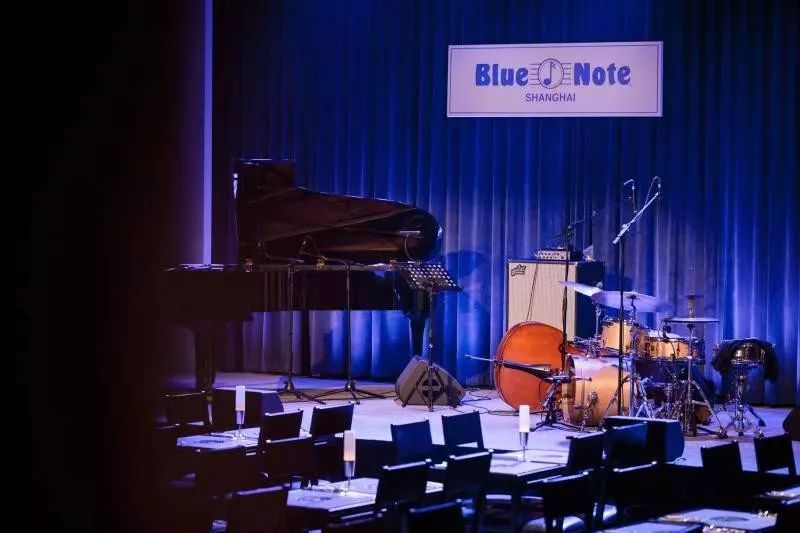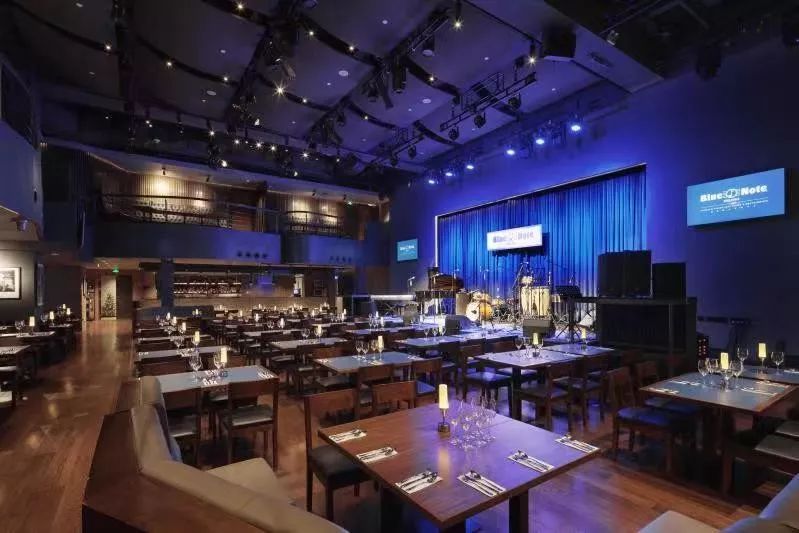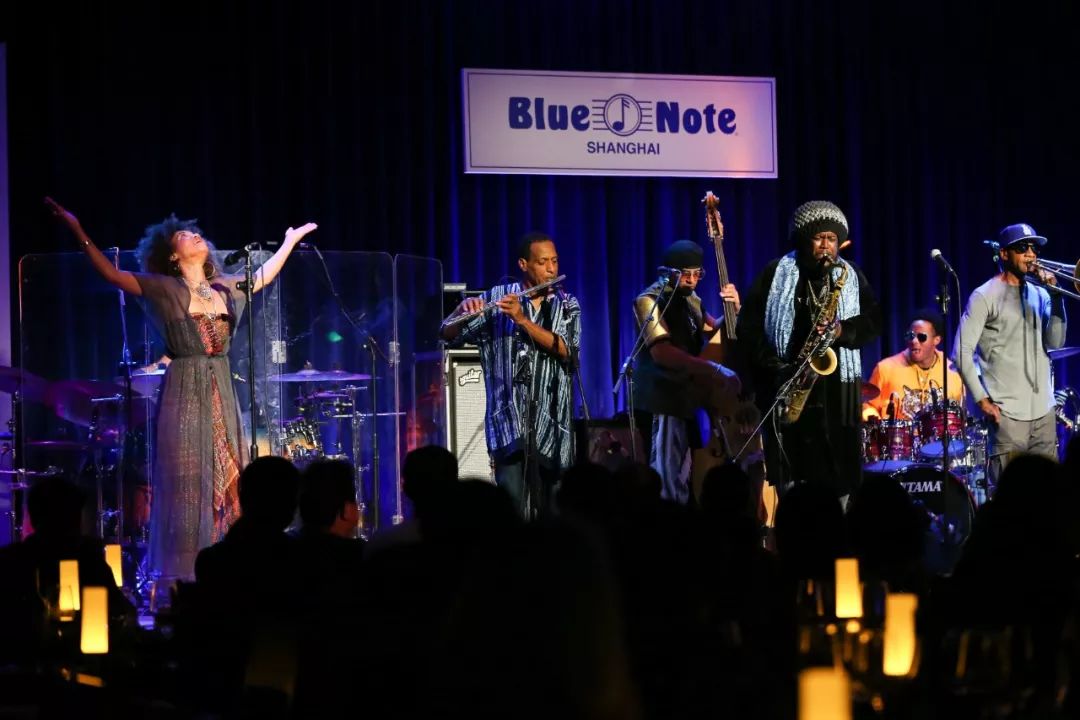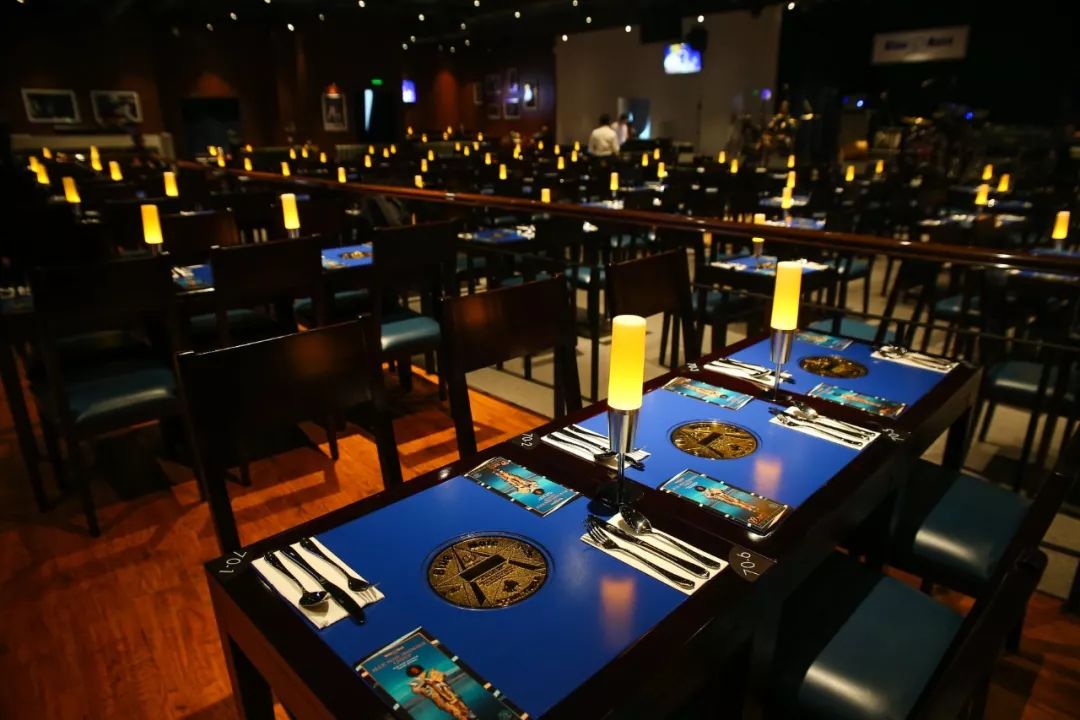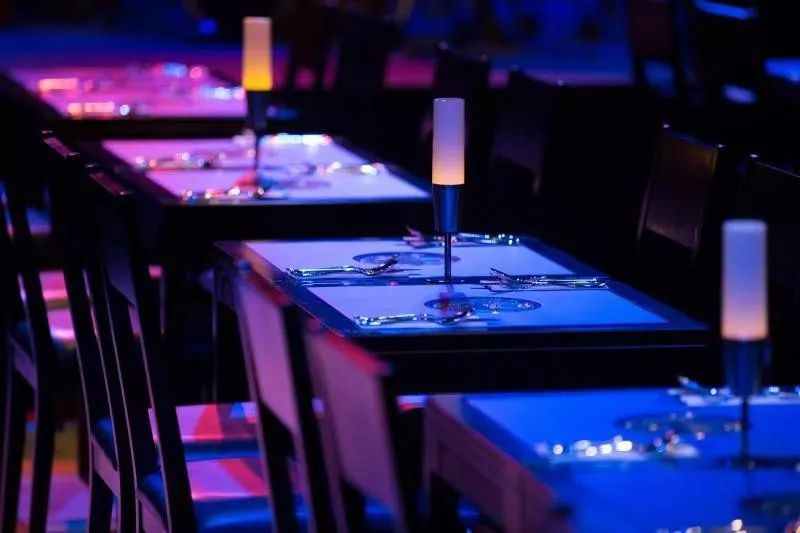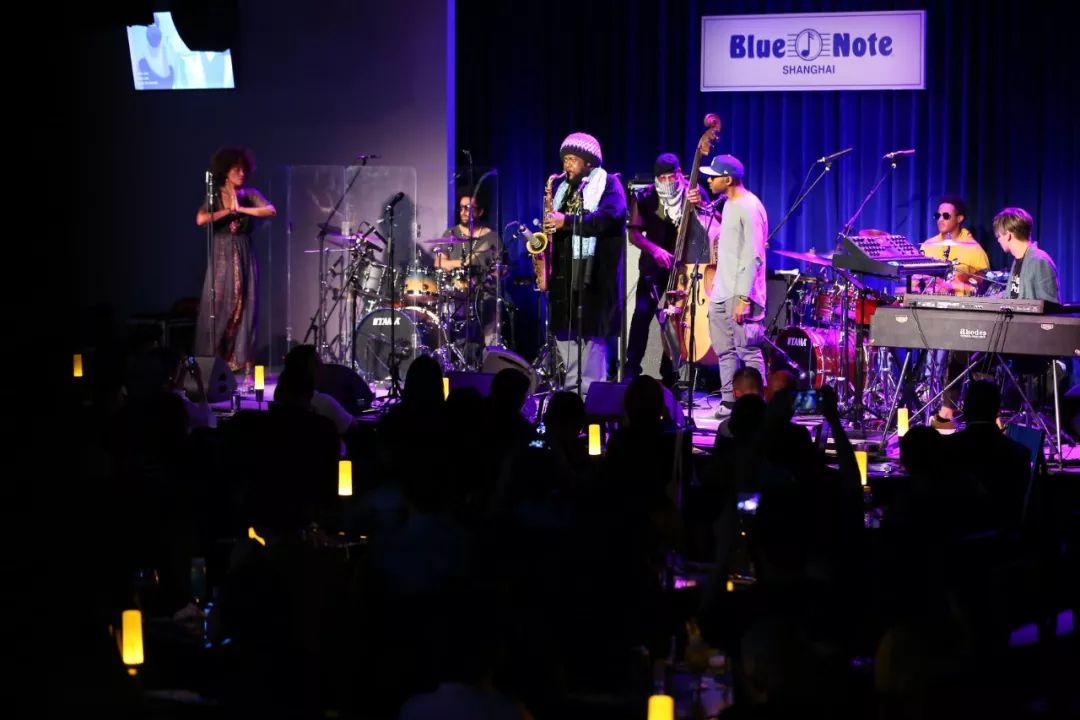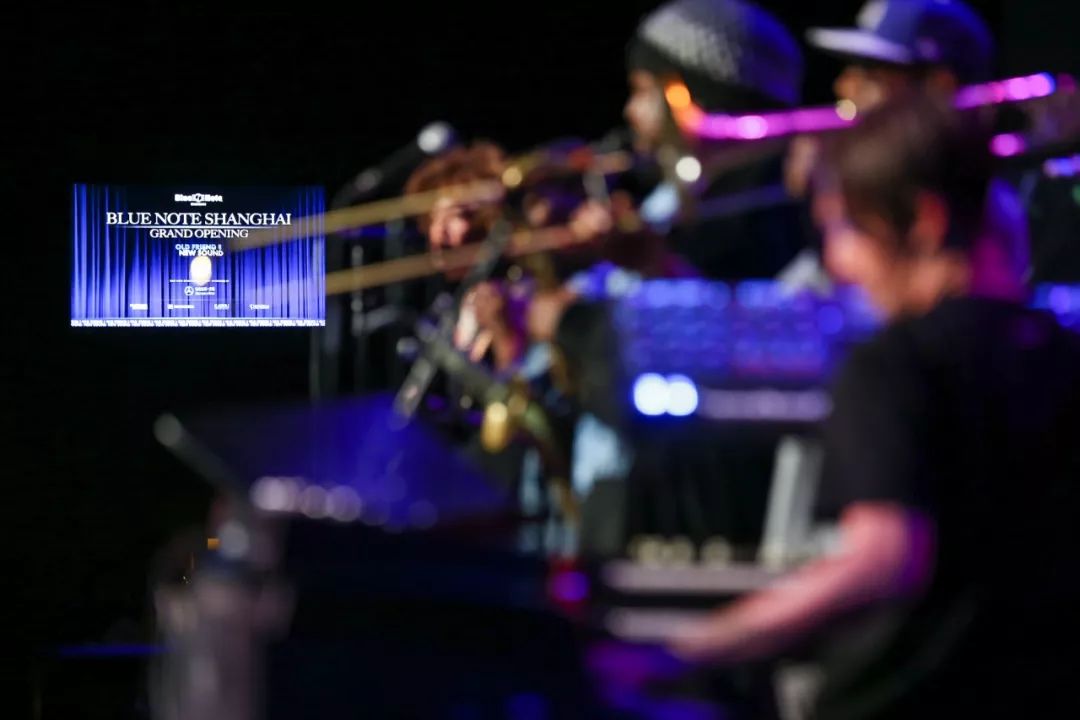Having a high quality jazz club has gradually become an integral part of urban culture.
Editor’s note: This article is from the WeChat public account “Music Finance” (ID: musicbusiness), author Anxixi.
In three years, Blue Note from Beijing to Shanghai, from jazz fans to the masses of visitors, everything is telling how the music-related lifestyles of this era are changing.
Music is the epitome of a city, Blue Note in New York and Tokyo, Ronnie Scott’s in London, and Sunset Sunside in Paris, with a high-quality jazz club that has become an integral part of urban culture.
On September 12th, one of today’s hottest jazz musicians, saxophonist Kamasi Washington, once again staged the Blue Note Beijing stage. Then he flew to Shanghai to perform a perfect jazz night for the Shanghai jazz fans at the Mid-Autumn Festival.
△Kamasi Washington
Guests come from all directions of this super city. Every guest takes a number plate, and the waiter leads to the corresponding position. Some people are chatting face to face, someone is quietly waiting. The performance began, and the space that was slightly deserted during this time in the past was very popular at this time. This is the CITIC Plaza located at No. 867 North Sichuan Road, Shanghai, where Blue Note Shanghai is located.
Three years ago, the jazz classic Blue Note finally crossed the ocean and began to make a fate with the Chinese local audience. A wave of jazz performances from Blue Note Beijing, combined with the nightly blue lights and various meals on the party table, has gradually become one of the daily life scenes of Beijing’s busy urban middle-class people. This Mid-Autumn Festival Blue Note announced that the Shanghai store is officially open.
In the past three years, what kind of jazz music business has Blue Note gone through? How will Blue Note Shanghai operate? Under the leadership of the 瀛寰 culture team, the Blue Note brand willLike the popular music and food brands in recent years, is there a way to expand?
1 Beijing Experience:Falling and Management
In 2013, Chairman of the Board of Culture and investor Tian Hao, led by friend and musician Li Zongsheng, came to Blue Note New York to watch the show. That night, he knocked on the door of the jazz club manager’s office.
Blue Note founder Danny Bensusan settled in Washington, DC in 1981 at the Washington Club in Greenwich Village, New York. The original intention was to combine the highest level of performance with a comfortable environment and cuisine. For decades, it is still the most in New York. One of the popular jazz clubs.
The Blue Note brand is very demanding for the review of the licensor. For many years, although it has landed in Milan, Italy, Tokyo, Japan, Nagoya, South America, St. Paul and other cities, the opening speed is extremely slow. Due to the strict quality requirements of Blue Note, each store of Blue Note has been very successful. The Tokyo store has become one of the music landmarks in the whole Asia Pacific region, contributing a high proportion of profits to the headquarters.
So, what about the larger Chinese market in the middle class? Obviously there is a greater commercial imagination.
According to the “2018 China New Middle Circle White Paper” published by Hurun Research Institute, the number of middle-class families in mainland China has reached 33.2 million, with Beijing, Guangdong and Shanghai accounting for half, of which more than 10 million are new middle-class. In this report, the new middle-class family is defined as a net asset of more than 3 million. After 80, it is the main force of the new middle class. They have high requirements for the individual spirit.
Under the big brother Li Zongsheng’s matchmaking, the Tian Hao team finally won the trust of the founder of Blue Note and signed the brand license for the entire Greater China region. After getting the contract, the team’s first challenge was the location of the first flagship store.
100 years ago, jazz landed in China’s cities, first of all the fashionable Oriental Paris, Shanghai. It can be said that Shanghai has the best jazz consumption soil in China. Tian Hao recalled that when he signed a cooperation with Blue Note six years ago, Shanghai was originally the first choice, but the core founding team is Beijing. For how to operate a jazz club, the team needs to find a more familiar market. With the operating model, Beijing has become the first stop of Blue Note.
Blue Note HeadquartersThe location requirements for the landing of the brand are very demanding. This search has passed three years.
In the end, Tian Hao set his sights on the basement of an old-fashioned building near Tiananmen Square. It was built in 1903 and is the seat of the former US Embassy in China. The building area is 3,000 square meters, which is excellent. The geographical location, or the use of underground space, is in line with Tian Hao’s positioning of the Blue Note China flagship store.
△Blue Note Beijing
But this choice is undoubtedly very risky, it means the company has to bear higher rent and renovation costs. As a result, Blue Note Beijing spent $6.5 million to complete the renovation, becoming the largest single store in the world for the Blue Note Jazz Club brand.
After the site selection and operation team was established, on September 13, 2016, Blue Note Beijing opened for business.
At the beginning of the business, the team arranged intensive performances, but did not achieve the expected market effect. After the resumption, the team lowered the frequency of the performance.
“Jazz music is still a niche culture in China, which makes customers’ perceptions of Blue Note and jazz more limited in their consumption, and it takes time to cultivate this market.< Span>”
Li Si, executive deputy general manager of 瀛寰 Culture, recalled that she was still working at Space Cycle and was the first guest of Blue Note, witnessing the whole process of Beijing store from 0 to 1. .
Because Tian Hao is one of the investors of Space Cycle, both brands are “music + lifestyle” mode. In August 2018, Li Si was invited to formally join the Blue Note team and started to be himself. The best business, from the perspective of the customer group to dock the brand cooperation. Three months later, she began to contact the planning and ticket management of professional performance content, summed up the operating model, and deposited these experiences into the preparations for the Shanghai store.
“We will be basically smoothed out in the second year. In May 2018, we started two bands of four bands in the week. We started our performance on Saturday in May this year. We saw that everyone gradually started to market. The pattern has opened, and we have increased the number of performances and introduced more bands,” Li Si said.
After the second year, the number of performances increased, and the performance and catering team became more familiar with each other.Ote Beijing is an important source of income. In terms of business, in addition to brand rental venues, in 2019, Mercedes-Benz and American Express cooperated as brands to present performances together with Blue Note.
One of the most important missions since the establishment of Blue Note China is still the high-density performance of top jazz masters in China, which is the root of the Blue Note brand. Many new generation masters have been invited to perform in China frequently. The list is full of famous musicians. The performances of Kamasi Washington, Roy Hargrove, Robert Glasper and Jacob Collier show the current and future of jazz.
In the interior of the Beijing store, from the stage, the performers are surrounded by the audience in both the horizontal and vertical directions, which not only satisfies the privacy social needs, but also the sound and music experience is more full and extreme. There are approximately 240 seats in the first floor lobby, all of which are flexible and detachable to accommodate non-standard performance features. There are 7 open viewing platforms on the second floor, all of which are different in size.
△Blue Note Beijing
From the fare point of view, usually the bar is 160 yuan / piece, the side seat is 260 yuan / piece, the main seat is 360 yuan / piece, this price also offsets the food and beverage expenses of 100 yuan. Even in the box on the second floor, the price of the box for 5 to 10 people is between 3,300 yuan and 6600 yuan.
This means that there is no way for the show box office to sell thousands of tickets like theaters and gymnasiums. There are only 240 seats available on the first floor and only 7 rooms on the second floor. 100% attendance. In the case, the box office income ceiling is also clearly visible. But as a performance-focused music restaurant, it can guarantee the benefits by increasing the number of performances.
In three years, Blue Note Beijing has become one of the most influential music life landmarks in Beijing with the team’s efforts. More than 300 artists, more than 1,000 performers, more than 200,000 viewers, these numbers are not easy for the Blue Note Beijing operations team.
Whether the performance of the show is growing at an average rate of 1.5 times per year, it is the continuous development of the audience attendance rate and the number of members, or the performance team, the catering and service team.The operating model is constantly improving in the recovery.
Beginning to 2019, Blue Note Beijing’s content operations and business feedback have reached a virtuous cycle, and Blue Note Shanghai has naturally come to the fore.
2 Shanghai: New places for new and old Kellers
On the evening of September 13, in the Blue Note Shanghai store, the performance brought by Kamasi Washington surprised the Shanghai audience.
Classical and understated, the corridor is long and spacious, with a picture of a master jazz on the wall. On the stage, the light blue light radiates a loverlike gentleness in the dark night, like a nebula in the depths of the universe. The light changes on the hat of Kamasi wrapped in its signature fluffy head, on the wide clothes, on the saxophone, he stands on the stage, the rhythm falls in all directions in the corner of the room, and a piece of music ends, he smiles and accepts Thunderous cheers.
Tian Hao said that Blue Note Shanghai’s business characteristics are still high-frequency international jazz performances, which is a perfect complement to the small and sophisticated Lincoln Center and JZ Club, which represents the Chinese jazz power.
The ideal state of Blue Note is to invite a group of musicians to come to China to perform in Beijing and Shanghai. “About 80% of the performances of the two places will be the same, but because of some schedule problems, there will be a small amount of content in the two cities.” Li Si said that Blue Note China needs to pay a fixed performance fee for a musician. With the hotel accommodation transportation fee in China, after the Shanghai store is opened, it can improve the efficiency of the performance and reduce the cost of inviting artists.
From the perspective of the consumer group, Blue Note Beijing’s customer base is the same as that of the top music theaters such as the National Centre for the Performing Arts. The lineup is top-notch, but Blue Note is more oriented to everyday life. Is a completely different music consumption experience. Shanghai already has the Lincoln Center and JZ Club, which has a rich jazz soil than any other city in China. There are many old-school fans who want to spend time watching jazz performances and new middle-aged people who are more fashionable.
The regrets of six years ago have finally become a reality. In a way, this also thanks to the commercial real estate iterative thirst for music content in the past three years,Compared with Beijing’s huge rental and renovation costs, Blue Note Shanghai’s financial pressure is much smaller. Strong support from commercial real estate partners in rents has also led to the opening of Blue Note Shanghai this fall.
△Blue Note Shanghai
Blue Note Shanghai store covers an area of over 1,700 square meters, and the performance hall can accommodate more than 300 people. Shanghai store stage decoration and catering operation mode are consistent with Beijing. The main team is in Beijing, the content and management model is exported from Beijing, and the operations team recruits local employees in Shanghai.
When designing the Shanghai store, Tian Hao, who used to wear sneakers, T-shirts and backpacks, traveled to and from Beijing-Shanghai, and was criticized by Shanghai friends for not having a “ceremonial feeling”. Therefore, in the construction of Blue Note Shanghai, Tian Hao was very confused. Is it to spend money on decoration, cups or plates or inviting bands? Can Shanghai accept a Blue Note that combines the American-style minimalist tradition with the Beijing-style practical style?
Tian Yu finally chose the best music, and settled the experience in Beijing for three years as a thoughtful service, and exported it to the Shanghai store. Jazz is paired with fine wine and music, and the music is integrated into the lifestyle of the middle class. But high-quality music is the protagonist, and food and wine is a side dish, which is a fundamental feature of Blue Note Shanghai that distinguishes it from other performance venues and music restaurants in the city.
Blue Note Beijing performs every night from Thursday to Sunday, 1 on Thursday and Sunday night, and 2 on Friday and Saturday nights. Every time, people can sit down at the bar or at the table and have dinner, which is also the atmosphere that Blue Note created from the beginning of the establishment and other old jazz bars in New York.
△Blue Note Shanghai
In the operation of the store, the Shanghai store does a lot of small details.Improvements.
For example, the square table of the Beijing store is long, and often needs to be a table, which invisibly distances the distance between the guests. Therefore, the design of the table in Shanghai shop is small, it is a table for 2 people, but it can also be made into a table for 4 people, which will make it more comfortable, and a small drawer is placed under each table to facilitate the use of tableware. This can avoid the situation that the service staff can’t respond to the customer’s needs in the first time during the music performance, and also reduces the chance of the people walking, so as not to block the sight of other guests.
Today, music restaurants are blooming all over the country. What is the next expansion plan for Blue Note?
Li Si confirmed that after having a stronghold in North China and East China, the next step, Blue Note will first consider entering South China. However, Blue Note will not expand on a large scale, because the brand temperament of Blue Note is different from that of all music restaurants on the market. The location and decoration of the venue, the arrangement of the performance, and the content of the catering and kitchen are very strict. Is a very fine, re-run model. Blue Note is only a direct store, and will not expand through extensive joining methods.
“We want to ensure the quality of each Blue Note store, which means we will be very cautious about opening a new store in a city.” Li Si said.
3 Jazz Trends: Fusion
Whether in New York or London, the content of jazz has been emerging in recent years. Fushion has become a big trend, and continues to integrate into a variety of emerging musical elements, and jazz has renewed its power.
This time in Shanghai, Kamasi grew up in Los Angeles, where electronic music is developed. He has a natural affinity for hip hop and electronic music. His impromptu energy is no less than any grand orchestra. The musician in a variety of musical styles has a strong sense of control and sense of jazz for each period.
Before, Blue Note WeChat officially compiled a song list combining jazz and hip hop, which was loved by many young people. The musician Feng Mantian combines the elements of national music and is also loved and praised by everyone in the Blue Note stage.
In 2019, Blue Note established the Jazz Big Band Blue Note China Jazz Orchestra started to plan for the top performance after successfully hosting the modern jazz band concert in March. In the second half of the year, it introduced the American Express brand sponsorship and presented the performance series of the big band exclusively.
Sun Kai, a music director at the Blue Note Big Band, is a tenor saxophone player, clarinetist, composer and writer living in Brooklyn, New York. “Jazz Trail” commented on him: “Sun Kai is a forward-looking musician. His music is rich. He is a talented saxophonist and comfortable in all kinds of music environments. Integration.”
Jazz music has no classical music full of ceremonial listening and appreciation. There is no pop-up, dazzling “appearance”, no rock, hip-hop, electric, punk, and the madness and fierceness of young people’s hormones. It penetrates into the daily lives of residents in a city in an incredible way, with a restrained, limited passion.
And a jazz club?
It’s not like the squares printed on travel postcards in a city. It’s not as common as the urban spirit of a city like museums, art galleries, or art galleries. But with it, it seems that the individual has an emotional connection with a city, a diet that never despise life, like buying a commodity in a supermarket, actually touching the music consumption. The sense of well-being.
Dialog
“We believe in the power of jazz.”
Music Business (ID: musicbusiness): What characteristics did Blue Note Beijing show at the box office in the past three years?
Li Si: From the box office, there are still some obvious trends: for jazz fans, they will like the performance of a certain jazz-type instrument, for most jazz music. Fans, they are very accustomed to this form of performance without vocals.
But our jazz classic trio, quartet, and mainly jazz fans like it, the public may sometimes feel a bit unintelligible, is it too quiet? On the contrary, there are people, especially when there are singing voices of girls, relatively speaking, the box office will be ideal; if the band’s lineup is relatively large, I am not referring to the importance (gallow), but the band’s comparison. More, six people look very lively and are very popular for mass consumption.
So for different customer groups, we will launch different show types. Later, we have already identified the artist’sAfter the performance, targeted promotion will also be carried out according to the different styles of the band to reach different consumer groups.
Music Finance: What is the current number of members in Beijing? Is there a data analysis between the new guest’s first visit to the store and the old guest?
Li Si: At present, WeChat has 50,000 subscriptions, and the number of members should be 20,000. The latter question, to tell the truth is not particularly good diagnosis, but from the membership growth can still reflect some characteristics, because there will be user information after the ticket purchase.
For example, from the current ticketing data of our current members and non-members, now more than 50% of each performance is still the first time to visit the store, 40-50% of the people who have a certain understanding of jazz, members are basically After registering, I will come over regularly and have a certain frequency of consumption. These people think that they are at least consumers who like jazz and have a certain understanding of jazz music.
Music Business: (ID: musicbusiness): Beijing store is difficult at the beginning, when is the turning point in operation?
Li Si: In the first year, the expectations were relatively high. I found that the market was not so mature. Later, the performances were reduced, and the market’s acceptance of jazz was gradually explored. At an easy-to-accept level, let’s make an invitation to a targeted band.
The market is gradually moving upwards. We are relatively smooth from the second year, basically returning to a stage that is relatively consistent with our initial expectations. By the third year, we have continued increase.
Music Business (ID: musicbusiness): What is the difference between a Chinese-speaking performance and a jazz musician coming from overseas?
Li Si: In fact, the two groups are not the same. Because jazz performances certainly attract jazz fans, or people interested in jazz, but Chinese performances are not, the vast majority attract fans who like this show.
But in fact, pop music, rock, folk music, we have also done a lot of cross-border attempts of performance types, basically the local jazz players in the box office income are also good, but really not so many people, so we Comparing the stores in South America, it is necessary to invite more jazz masters from the headquarters to perform, which is the guarantee of our quality. We are also doing jazz classes, doing some education-related things with the show, hoping to help more local jazz musicians.
Music Business: What are the stores in Blue Note China and other countries?Is it different?
Li Si: Relatively speaking, New York has its own very stable group of customers, but overall there is a trend of aging development, and local young people are more aware of pop music. Interest, prefer new forms of music, so the age group is larger than the Chinese side.
In addition, geographical factors are also quite different. For example, in South America and Brazil, because Blue Note has Rio and São Paulo stores, their performances are very localized, because Latin-style jazz is very popular in the local area, so this The two clubs staged the local musicians, the artist costs are lower than us, and the overall box office is quite good.
Music Business: Blue Note is doing other forms of performance. At first, there was some controversy. Now?
Li Si: In fact, this is a process of running in. We are constantly telling the market what kind of business we are, and what kind of mentality we are holding to do this. For us, this is a business. The perspective of this matter will be more rational and will hope to operate through a more open mind. In fact, it can only be operated under a more open mind, because then you can understand where the real customer base and market are.
We have to think differently. To understand how most guests feel, how do they view jazz live performances? In fact, everyone will express their own views on each form of music, and each different form of music, the business model will be different for the customer group itself. We were more open and inclusive from the beginning, and we were greeted by a more rational audience.
Music Business: How to treat music content in recent years is getting more and more popular with commercial real estate developers?
Li Si: Commercial real estate has developed to this stage, gradually paying attention to various forms of lifestyle related to music. I think it is the same as we do jazz. Everyone values the consumption potential of the lifestyle. The combination of live music and commercial real estate should be a matter of course, sharing some costs and risks, and it is a reasonable win-win model.
